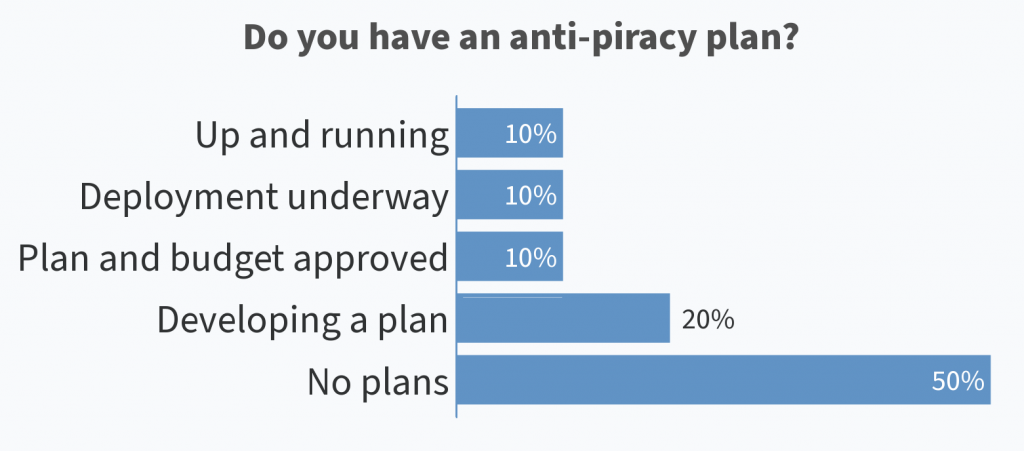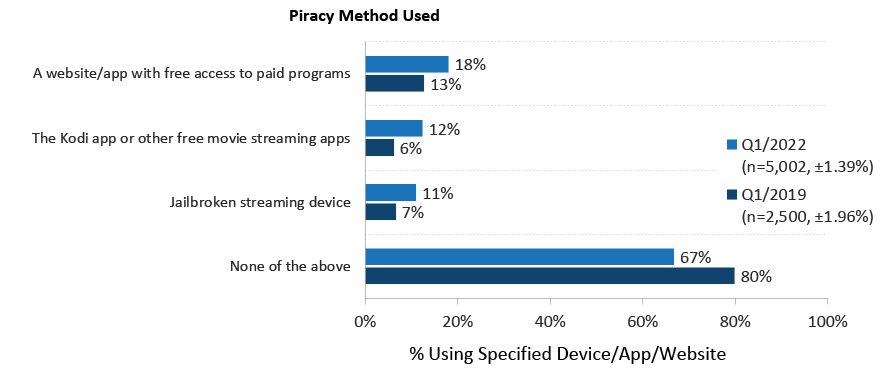As multiple research sources report increases in piracy rates around the world, the media & entertainment industry could do more against it; at least according to an informal poll conducted at the 2022 Future of Video conference, where half of the respondents admitted to having no anti-piracy plans. The event is held annually by Parks Associates in California.
Fortunately, the conference offered multiple opportunities to learn about it. Piracy Monitor’s Steve Hawley moderated two session about piracy, and a third about the progress of Smart TVs.

Password sharing is “still” a thing
A panel discussion called Password Sharing: Protecting Content with New Revenue Models, explored ways to recoup lost revenue from credential fraud. There’s password sharing among friends and family, which carries a risk that they may share with others, and like the old TV ad, “and they tell two friends, and they tell two friends, and so on…”
The more damaging form of credential fraud is ‘indudustrialized’ fraud, in which pirates buy databases for pennies-per-hundreds of IDs and passwords, and then set aside media accounts that those credentials unlock, for resale. In turn, those consumers could be victimized by phishing attacks, ransomware, and fraudulent software downloads.
Two approaches against password sharing
Video providers take two approaches against password sharing: the carrot and the stick. Consumers who are reluctant to take ‘yet another streaming service’ have responded well to positive incentives. In fact, “AVOD and downloads could bring you an audience you otherwise may never have.” said panelist Brian Kline, President and COO of Penthera, which provides SDKs and monetization solutions to enable apps for download models, which is in use by video providers that include Paramount Plus and LG.
The other approach against password sharing is to wield a stick to discourage potential piracy, such as forcing the user to change passwords, degrading service or cutting off supply through detection and blocking. Or, as Netflix has been testing, charging for out-of-household users. But this runs the risk of alienating legitimate end users. The challenge is showcased in a recent Wall Street Journal article (paywall) and the reader comments to it.
Katy Oberdiek, Product Marketing for Intertrust, Olga Kornienko, COO of EZDRM, and Ken Gerstein, Nagra’s VP of Sales for Anti-Piracy and NexGuard, rounded out the panel.
New Approaches to Piracy
Our other piracy session, New Approaches to Piracy and Future Threats, highlighted industry shifts in addressing piracy, including the evolving nature of threats and best practices in content and service protection.
Consumers are frequently blamed for the piracy problem – by sharing passwords, buying illegal streaming devices, and accessing streaming ‘IPTV’ Web sites. “But we, the industry, are equally to blame,” said Lisa Wasikowski, Head of Client Solutions for Synamedia. “OTT bills are almost as big as our old cable bills – and streaming looks more and more like pay TV. Look at super-aggregators like Roku,” she said.
True, although Parks Associates research says that about two thirds of piracy occurs outside of illegal or jailbroken (rooted) devices and IPTV sites that are commonly used by consumers.

Another observation was that pirates are getting better at stealing video releases that are available legitimately in one territory, and getting them into territories before the right release window. Studios and TV programmers are losing many millions of dollars.
What does it take to drive consumers back to legitimate services? In addition to the aforementioned carrots and sticks, another way is for governments to pass legislation that allows or requires Internet providers to block pirate sites and IP address, which is becoming increasingly common in Asian countries, is on the docket in Europe, and is being ‘strongly encouraged’ in the US and Latin America.
“The investment in anti-piracy is small, relative to the size of the problem,” commented Ken Gerstein of Nagra. In 2019, a Parks Associates report estimated that by 2023, the value of pirate video services could exceed $67 billion worldwide. Parks Associates is currently in the process of updating that report.
The other panelists were Mike Baron, Friend MTS SVP of Sales and Strategy and Lisa Spencer, Irdeto’s VP of Marketing. All told, Parks Associates is congratulated for attracting some of the industry’s true leaders to participate in these panels.
Why it matters
Admittedly, the sample size of those surveyed about their anti-piracy plans was small and – being comprised of a mix of video distributors, video technology vendors, market researchers and journalists – the environment was somewhat artificial. But the result does approximate what Piracy Monitor hears “around the industry” and this leaves major room for improvement.
Fortunately, the understanding of the major use-cases associated with piracy is improving, and events like this one really help. We’ll expect that the industry’s adoption of anti-piracy solutions and practices will also have improved in a year from now.












